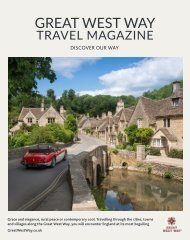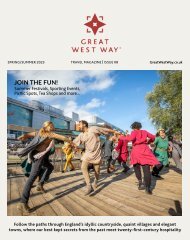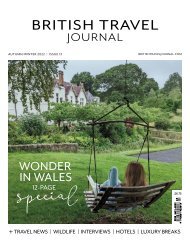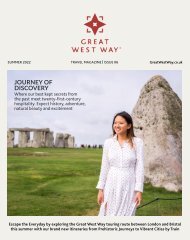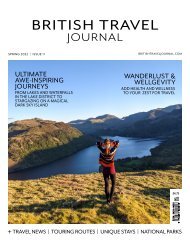British Travel Journal | Summer 2020
As we went to print with our last issue never could we have imagined a world in which travel would be completely stopped in its tracks. Never again will we take for granted our freedom to visit our magnificent cityscapes, captivating coastlines and peaceful countryside. It has been a difficult year for the hospitality and travel sector, but as this issue of British Travel Journal shows many are beginning to reopen, delighted to welcome back visitors and guests once more. We speak to these resilient hoteliers, destination managers, and others in the UK tourism industry about how they have responded to COVID-19. Our Cultural Agenda takes on a new direction, exchanging theatre performances for outdoor art, sculptures and natural wonders. And, in a time when remote locations are being sought after, all you need to know about wild (and nearly wild) camping is covered in our Sustainable Travel series. If camping isn’t for you, help is at hand to find the perfect holiday home in our 10 of the Best Self-Catering Properties. If you’re dreaming of strolls along the shore, fresh sea air and gently lapping waves, then you will love our coastal specials; Revival of the Beach Hut, England’s Coast, Wild Swimming and Secret Islands. Enjoy a taste of Cornwall in our Interview with Rick Stein before heading to the beach workshop of wooden bellyboards in our Meet the Maker: Wave Rider article with Dick Pearce. Finally, thank you to all our subscribers for your support, keeping our spirits high with words of encouragement and understanding the unusual delay in receiving this issue. Together we continued to dream of the extraordinary places we can explore, staying inspired with online and digital features, and hopefully by the time of reading this issue our next great adventures will have become reality.Travel safely, and together we will continue to support our wonderful tourism industry.
As we went to print with our last issue never could we have imagined a world in which travel would be completely stopped in its tracks. Never again will we take for granted our freedom to visit our magnificent cityscapes, captivating coastlines and peaceful countryside. It has been a difficult year for the hospitality and travel sector, but as this issue of British Travel Journal shows many are beginning to reopen, delighted to welcome back visitors and guests once more. We speak to these resilient hoteliers, destination managers, and others in the UK tourism industry about how they have responded to COVID-19. Our Cultural Agenda takes on a new direction, exchanging theatre performances for outdoor art, sculptures and natural wonders. And, in a time when remote locations are being sought after, all you need to know about wild (and nearly wild) camping is covered in our Sustainable Travel series. If camping isn’t for you, help is at hand to find the perfect holiday home in our 10 of the Best Self-Catering Properties. If you’re dreaming of strolls along the shore, fresh sea air and gently lapping waves, then you will love our coastal specials; Revival of the Beach Hut, England’s Coast, Wild Swimming and Secret Islands. Enjoy a taste of Cornwall in our Interview with Rick Stein before heading to the beach workshop of wooden bellyboards in our Meet the Maker: Wave Rider article with Dick Pearce. Finally, thank you to all our subscribers for your support, keeping our spirits high with words of encouragement and understanding the unusual delay in receiving this issue. Together we continued to dream of the extraordinary places we can explore, staying inspired with online and digital features, and hopefully by the time of reading this issue our next great adventures will have become reality.Travel safely, and together we will continue to support our wonderful tourism industry.
Create successful ePaper yourself
Turn your PDF publications into a flip-book with our unique Google optimized e-Paper software.
STOURHEAD<br />
Near Mere, Wiltshire<br />
The world-famous landscape garden at<br />
Stourhead has been delighting visitors for over<br />
250 years. At its centre is a magnificent lake<br />
surrounded by classical temples, mystical grottoes<br />
and rare and exotic trees.<br />
In Pride and Prejudice (2005) a rain-soaked<br />
Darcy makes his first, unsuccessful proposal to<br />
a rain-soaked Lizzie at Stourhead’s Temple of<br />
Apollo. Set high above the lake, the dramatic<br />
setting and beauty of the Temple proved perfect<br />
for this intense and romantic scene. So perfect<br />
in fact that the film’s director Joe Wright didn’t<br />
need Adam Richards, the film’s location manager,<br />
to go and look for a setting for this scene as Joe<br />
had always imagined it taking place here. Adam<br />
explained why the Temple was the director’s<br />
first and only choice: ‘Joe loved the idea of this<br />
emotional scene being played out while sheltering<br />
from the elements. The Temple, with its elevated<br />
position over the gardens below, was the ideal<br />
backdrop.’<br />
Visit to explore the 1,072 hectare (2,650 acre)<br />
Stourhead estate where chalk downs, ancient<br />
woods and farmland are managed for wildlife.<br />
Top tip: Uncover the fascinating history of<br />
Stourhead House with an Italian ‘Grand Tour’<br />
adventure and enjoy the unique Regency<br />
library, Chippendale furniture and inspirational<br />
paintings. The Palladian house is set amid ‘picnic<br />
perfect’ lawns and extensive parkland.<br />
Pictured left and above: The world-famous landscape garden at<br />
Stourhead; Keira Knightley as Lizzie Bennet at the Temple of Apollo.<br />
Pictured below: Botallack's Wheal Crowns building. Pictured right:<br />
Luke Evans as Vlad in Dracula Untold; The world-famous basalt columns<br />
of Giant's Causeway; Matt Smith as Doctor Who at Dyrham Park.<br />
BOTALLACK<br />
On the Tin Coast, near St Just, Cornwall<br />
If there was a National Trust award for the most<br />
used location for one TV series, Botallack would be<br />
sure to win. The buildings here stood in for various<br />
Poldark family mines in all five series of the BBC’s hit<br />
adaptation of Winston Graham’s novels.<br />
The Wheal Crowns buildings (shown right),<br />
perched on jagged rocks right next to the sea, were<br />
used as Francis Poldark’s failing ‘Wheal Grambler’<br />
in series one. Botallack is part of the Cornwall and<br />
West Devon Mining Landscape UNESCO World<br />
Heritage Site. The abandoned mines now serve as<br />
a reminder of the area’s once prosperous past when<br />
mines stretched out half a mile under the sea bed<br />
and produced thousands of tons of copper and tin<br />
every year.<br />
90 <strong>British</strong><strong>Travel</strong><strong>Journal</strong>.com




